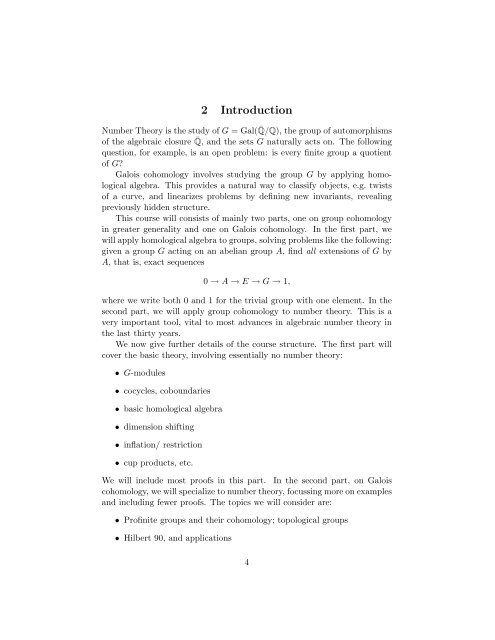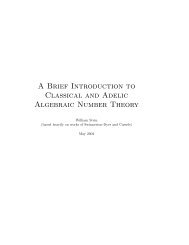A Short Course on Galois Cohomology - William Stein - University of ...
A Short Course on Galois Cohomology - William Stein - University of ...
A Short Course on Galois Cohomology - William Stein - University of ...
You also want an ePaper? Increase the reach of your titles
YUMPU automatically turns print PDFs into web optimized ePapers that Google loves.
2 Introducti<strong>on</strong><br />
Number Theory is the study <strong>of</strong> G = Gal( ¯ Q/Q), the group <strong>of</strong> automorphisms<br />
<strong>of</strong> the algebraic closure ¯ Q, and the sets G naturally acts <strong>on</strong>. The following<br />
questi<strong>on</strong>, for example, is an open problem: is every finite group a quotient<br />
<strong>of</strong> G?<br />
<strong>Galois</strong> cohomology involves studying the group G by applying homological<br />
algebra. This provides a natural way to classify objects, e.g. twists<br />
<strong>of</strong> a curve, and linearizes problems by defining new invariants, revealing<br />
previously hidden structure.<br />
This course will c<strong>on</strong>sists <strong>of</strong> mainly two parts, <strong>on</strong>e <strong>on</strong> group cohomology<br />
in greater generality and <strong>on</strong>e <strong>on</strong> <strong>Galois</strong> cohomology. In the first part, we<br />
will apply homological algebra to groups, solving problems like the following:<br />
given a group G acting <strong>on</strong> an abelian group A, find all extensi<strong>on</strong>s <strong>of</strong> G by<br />
A, that is, exact sequences<br />
0 → A → E → G → 1,<br />
where we write both 0 and 1 for the trivial group with <strong>on</strong>e element. In the<br />
sec<strong>on</strong>d part, we will apply group cohomology to number theory. This is a<br />
very important tool, vital to most advances in algebraic number theory in<br />
the last thirty years.<br />
We now give further details <strong>of</strong> the course structure. The first part will<br />
cover the basic theory, involving essentially no number theory:<br />
• G-modules<br />
• cocycles, coboundaries<br />
• basic homological algebra<br />
• dimensi<strong>on</strong> shifting<br />
• inflati<strong>on</strong>/ restricti<strong>on</strong><br />
• cup products, etc.<br />
We will include most pro<strong>of</strong>s in this part. In the sec<strong>on</strong>d part, <strong>on</strong> <strong>Galois</strong><br />
cohomology, we will specialize to number theory, focussing more <strong>on</strong> examples<br />
and including fewer pro<strong>of</strong>s. The topics we will c<strong>on</strong>sider are:<br />
• Pr<strong>of</strong>inite groups and their cohomology; topological groups<br />
• Hilbert 90, and applicati<strong>on</strong>s<br />
4
















